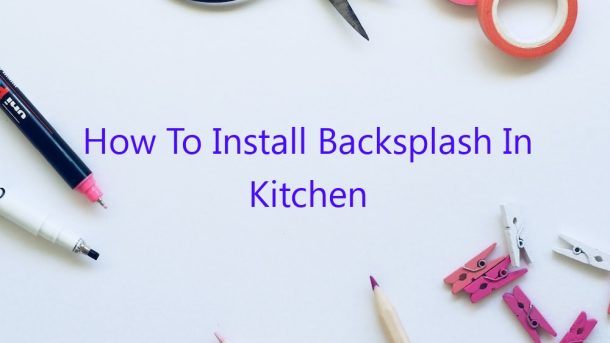Installing a kitchen backsplash is a great way to add personality and character to your cooking area. Not only that, but a backsplash can also protect your walls from splashes and spills.
There are a few things to keep in mind when installing a kitchen backsplash:
-Measure the area you want to cover and buy the appropriate amount of tile.
-Decide on the style and design of your backsplash.
-Prepare the surface of your walls by cleaning and leveling them.
-Lay out the tile according to your design, and use a tile cutter or a wet saw to cut them to size.
-Apply adhesive to the back of the tiles and press them into place.
-Allow the adhesive to dry completely before grouting.
-Grout the tiles using a grout float, and then clean up any excess grout.
-Allow the grout to dry completely before applying a sealant.
Contents
- 1 What is the easiest way to install kitchen backsplash?
- 2 Where do you start when laying backsplash?
- 3 Can you put backsplash directly on drywall?
- 4 How do you attach a backsplash to a wall?
- 5 Does backsplash go behind stove?
- 6 Do you line up backsplash with countertop or cabinet?
- 7 Should backsplash go to end of counter or cabinet?
What is the easiest way to install kitchen backsplash?
Installing a kitchen backsplash can be a daunting task, but it doesn’t have to be. There are several ways to approach the project, and the easiest way to install kitchen backsplash may not be the method you expect.
One option is to attach the backsplash directly to the wall behind the stove or sink. This can be done with adhesive or with nails or screws. However, this method can be difficult if the wall is not perfectly smooth.
Another option is to install a metal or plastic panel behind the stove or sink and attach the backsplash to the panel. This is a more common method, and it is relatively easy to do. You can find panels that are specifically designed to be used as backsplashes, or you can use a panel that is the same color as your walls.
A third option is to use a tile backsplash. This option can be a bit more difficult than the other two options, but it can also be more rewarding. You can use any type of tile you want, and you can create a design that is unique to your kitchen.
The easiest way to install kitchen backsplash is to use a panel that is already designed for that purpose. These panels are easy to install, and they come in a variety of colors and designs.
Where do you start when laying backsplash?
When it comes to home improvement projects, many people may feel overwhelmed at the thought of starting something new. However, when it comes to laying a backsplash, you may find that it is a relatively easy task, especially if you already have a general idea of what you would like it to look like.
To get started, you will need to measure the area where you would like to install the backsplash. This can be done by measuring the height and width of the area and then subtracting a few inches from each measurement to account for the grout. Once you have your measurements, you will need to purchase some tile and adhesive.
Next, you will want to prep the area by removing any old tile or adhesive and cleaning the surface thoroughly. Once the surface is prepared, you can begin to lay the tile. If you are using a staggered pattern, make sure to leave a ¼” gap between the tiles. Once the tile is in place, you can apply the adhesive and then let it dry for 24 hours.
Finally, you will need to seal the grout. This can be done by applying a grout sealer to the grout lines and then letting it dry. Once it is dry, you can then polish it with a brush or a cloth.
Can you put backsplash directly on drywall?
Can you put backsplash directly on drywall?
Many people want to know if they can put backsplash directly on drywall. The answer is yes, you can. However, you may need to do a few things to make it work.
The first step is to make sure the drywall is in good condition. You’ll need to patch any holes or cracks, and make sure the surface is smooth.
Then, you’ll need to apply a coat of primer to the drywall. This will help the backsplash stick to the surface.
Finally, you’ll need to apply a coat of adhesive to the drywall. Be sure to follow the instructions on the adhesive, as each type is different.
Once the adhesive is dry, you can install the backsplash. Be sure to use silicone caulk to seal the seams between the backsplash and the wall.
How do you attach a backsplash to a wall?
There are a few ways to attach a backsplash to a wall. The most common way is to use tile adhesive and grout. You can also use mortar to attach the backsplash.
To attach the backsplash with tile adhesive and grout, you will need a tile adhesive, grout, trowel, sponge, level, and pencil. First, apply the tile adhesive to the wall using the trowel. Make sure to cover the entire surface. Then, place the backsplash in the desired location and press it against the adhesive. Use a level to make sure it is straight. Allow the adhesive to dry for 24 hours. Then, use the grout to fill in the spaces between the tiles. Make sure to use a damp sponge to wipe away any excess grout. Allow the grout to dry for 24 hours.
Does backsplash go behind stove?
There are many questions homeowners have when they are remodeling their kitchens, and one of the most common is whether or not to put a backsplash behind the stove. Here are the facts on whether or not a backsplash goes behind a stove.
Backsplashes are primarily used to protect walls from spills and splatters. When you have a stove, there is a greater risk of spills and splatters, so a backsplash is a good idea in that case. A backsplash can also help to brighten up your kitchen by adding some color or pattern to the wall.
If you are considering putting a backsplash behind your stove, there are a few things to keep in mind. First, you need to make sure that the backsplash is fire-resistant. Many backsplashes are made of materials like tile or marble that are not fire-resistant, so be sure to check before you buy.
You also need to make sure that the backsplash is tall enough to protect the wall from spills and splatters. Most backsplashes are at least six inches tall, but you may want to go taller if your stove is particularly prone to spills.
Finally, you need to make sure that the backsplash will be easy to clean. Backsplashes that are made of tile or marble can be difficult to clean, so if you choose one of those materials, be sure to choose a style that is easy to clean.
In conclusion, if you are considering putting a backsplash behind your stove, there are a few things to keep in mind. Make sure that the backsplash is fire-resistant, tall enough to protect the wall, and easy to clean.
Do you line up backsplash with countertop or cabinet?
There are a few different schools of thought on whether or not to line up your backsplash with your countertop or cabinet. Here’s a look at each one.
Aligning your backsplash with your countertop or cabinet is a way to create a more seamless look in your kitchen. It can be a great way to make a small kitchen feel more spacious, since it eliminates any visual breaks in the line of the countertop.
However, some people don’t like the look of a backsplash that’s perfectly aligned with the countertop or cabinet. They find it too formal or too symmetrical. If this is the look you’re going for, then you should definitely line up your backsplash with your countertop or cabinet.
But if you’re looking for a more casual or eclectic look, you may want to consider aligning your backsplash with the wall instead. This will create a more relaxed and natural feel in your kitchen.
Should backsplash go to end of counter or cabinet?
There is a lot of debate surrounding the topic of whether or not backsplash should go to the end of counter or cabinet. Some people argue that it looks neater and more polished when the backsplash goes all the way to the end of the counter or cabinet. Others argue that it is easier to clean when the backsplash doesn’t go all the way to the end, because you can easily clean the counter or cabinet without having to worry about getting the backsplash dirty.
Ultimately, the decision of whether or not to have backsplash go to the end of counter or cabinet is up to the individual. If you think it looks neater and more polished, then go for it! If you think it is easier to clean when the backsplash doesn’t go all the way to the end, then that is what you should do.




